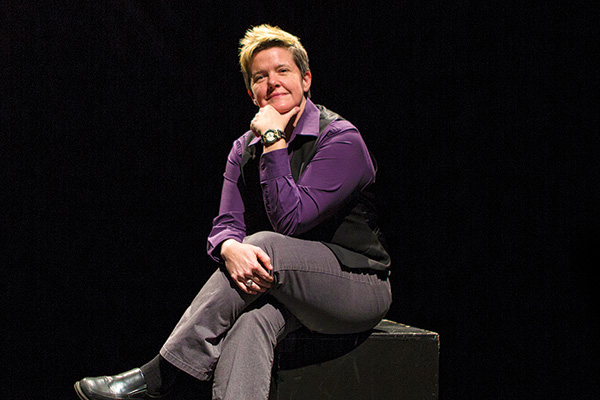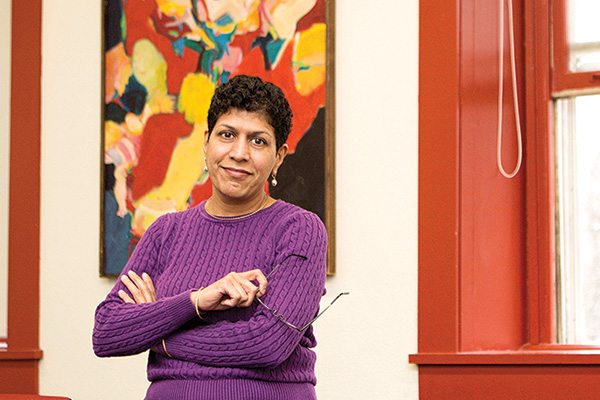Reconstructing Zapotec tombs in 3D
On a June day under the southern Mexican sun, three women make their way to the top of an acropolis high above the Central Valleys of Oaxaca (wah-HAH-ka).
 At the top, they look out across the valley to the mountains that encircle it, a stunning view that entranced and delighted the people who settled here starting 2,500 years ago.
At the top, they look out across the valley to the mountains that encircle it, a stunning view that entranced and delighted the people who settled here starting 2,500 years ago.
This is the site of Monte Albán, the ancient capital of the Zapotec culture and one of the oldest-known cities in Mesoamerica. Inhabited over a period of 1,500 years, the site consists of terraces, pyramids, dwellings, and tombs. Lots and lots of tombs.
The three women have journeyed here from Cornell College to learn more about Zapotec art. They are Ellen Hoobler, assistant professor of art history, and her students, Ve’Amber Miller ’15 and Catherine Quinn ’15. Today, their task is to measure Tomb 118, the first step in recreating the tomb using 3D computer technology.
“Our work builds on the efforts of Alfonso Caso, one of Mexico’s greatest 20th century archaeologists,” Hoobler says. “He was the first to scientifically excavate Monte Albán, beginning in 1931.”
During 18 seasons excavating Monte Albán, he produced more than 10,000 catalogue cards, each containing information about a particular artifact found at the site.
“Alfonso Caso pioneered archaeological records like these in Mexico, as far as I can tell,” Hoobler says. “They include a description of the piece, the number of the tomb in which it was found, and a precise description of its location within the tomb. Many of them also include a photograph and a color drawing of the piece. The color drawing was important because so often, the original colors have been almost completely lost for the pieces today—they fade very quickly once objects are removed from these stable environments.”
For Hoobler, Monte Albán is almost like home.
“I first visited the place when I was an undergraduate student,” she says. “I came to Oaxaca during a January term program. That was the beginning of my love of Zapotec art, especially the Zapotec ceramic effigy vessels like those excavated by Professor Caso.”
Hoobler lived in Mexico City in 2007-08, “chasing Caso’s ghost around Mexico” while she pursued her Ph.D. from Columbia University. She photographed 8,000 of Caso’s cards and used them to create a searchable electronic database of the objects he had cataloged.
“I used the database to make exact plans of the placement of objects in the tombs,” she says. “Doing that was important because the arrangement of the urns and other objects was some type of message from the family to their dead.”
Her ultimate goal was to turn the floor plans into 3D reconstructions of Tombs 104 and 118, which was what brought her to Monte Albán with the students in the summer of 2014.
“The students created 3D models of the artifacts using my database, the Maxon Cinema 4D software, and a video game engine called Unity,” she says. “These kinds of skills will really set the students apart to potential employers. I had learned about Unity during an National Endowment for the Humanities Digital Humanities Workshop. I recommended it to the students, but I let the students dig in and figure out how to do the modeling.”
Quinn modeled Tomb 118 in Unity software, but could not place virtual objects in the tombs because none of the computers on campus had the capability to do that kind of rendering.
However, another student a summer later would devise a new way to solve that problem. Arturo Hernandez Jr. ’16, a double major in studio art and computer science, adapted the motion-tracking feature of the software Blender, which he taught himself, for the project.
“Motion tracking was introduced to me by Professor Derin Sherman in the Physics Department,” Hernandez writes on the project’s website. “He showed me a clip of an attempt he made at using motion tracking. Ellen and I looked at each other and thought it would be cool to put our virtual 3D objects in a video that we would film of one of the empty tombs.”
In September 2015 Hernandez was invited to present about some of his work at Monte Albán, at the conference “Cultural Patrimony and New Technologies,” at the Museo Nacional de Antropología, the most-visited museum in Mexico. His trip was financed in part by a grant from Cornell’s Berry Center for Economics, Business, and Public Policy.
“It’s important that students do work that has meaning,” Hoobler says. “I encourage them to do what art historians do. For example, writing catalog entries for real exhibitions, writing papers for journals, and learning how to apply for an exhibition grant.”
Hoobler shows students that complex issues can be addressed from a number of different perspectives and that technology can offer us a window into the past.
“It’s really satisfying to see ancient objects and catalog cards of the early 20th century take on a new life in the form of digital models and 3D printed objects,” she says.
Professor Hoobler describes the project in a 90-second Tiny Talk.
Visit the website created by Professor Hoobler and her students to document the project.
Watch senior Arturo Hernandez Jr.’s presentation (in English, beginning at 18:00 on the video).




